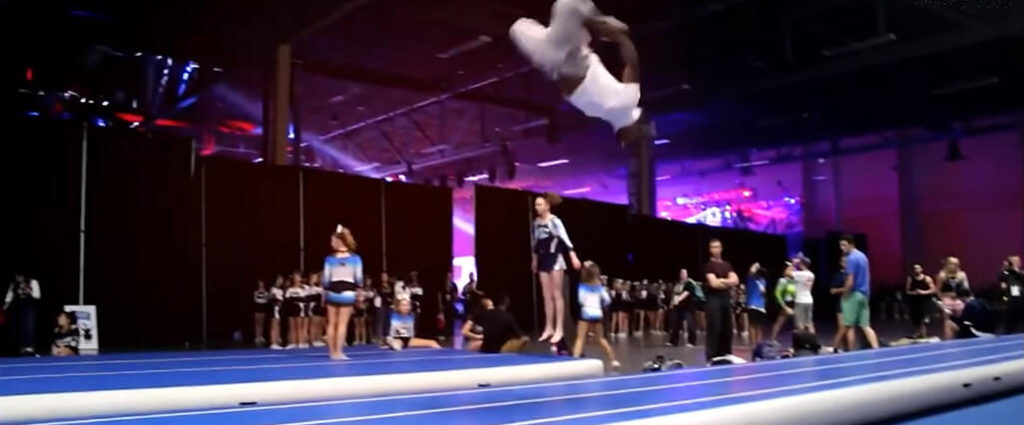
Cheerleading requires a lot of strength to toss other cheerleaders, ample balance and dexterity for those at the top of a pyramid and sufficient aerobic fitness to cheer throughout a sports game. Modern cheer is about building strength, confidence, and learning how to work as a team. Kids as young as four are drawn to this dynamic sport, creating an increase in the demand for high-quality cheerleading mats and equipment. Cheerleading mats are essential for helping athletes build strength, stretch, and learn skills and stunts. Consequently, the sport offers several important health benefits.
Light exercises and stretches or the cooldown phase help prevent any injury, increase blood flow, and reduce stress to your heart and muscles. Breathing in deep while cooling down before or after your workout helps deliver oxygen to your muscles, release tension, and promote relaxation. Bringing your heart rate and body temperature back to normal levels before you continue with your usual activities will help loosen strain in your body.
● Light jogging or walking
One of the most straightforward ways to cool down or warm-up is 10 minutes of jogging and/or walking. This is a great way to prepare your body for a tough workout. Alternating between 2 minutes of walking and 2 minutes of jogging is a great way to warm-up and increase that blood flow.
● Upper body stretch
1. Either from a standing or seated position, interlock your fingers together and press your hands up towards the sky.
2. Draw your hands up and back as far as you can while maintaining a straight spine.
3. Place your dominant arm in front of the other and turn your palms to face each other, stretching your hands up and back.
4. Repeat on the opposite side.
● Seated Forward Bend
1. Sit with your legs extended in front of you.
2. Lift up your arms.
3. Hinge at your hips to fold forward.
4. Place your hands on your legs or the floor.
5. Hold this position for at least 1 minute.
● Knee-to-Chest Pose
1. Lay on your back with one leg bent or extended.
2. Draw your other knee in toward your chest, interlocking your fingers around the front of your shin.
3. Hold this position for at least 1 minute.
4. Repeat on the opposite side.
● Reclining Butterfly Pose
1. Lay on your back with the soles of your feet together and your knees out to the sides.
2. Place your arms alongside your body or overhead.
3. Hold this position at least 5 minutes.
● Pike Sit
Sitting on the floor grab your toes and left both your heels off the ground, then grab your heels with legs locked and pointed
● Right Split
Your right knee is up and your left knee is down. Make sure that you have good posture so you need to push your hips forward while keeping your chest up.
● Left Split
Your left knee is up and your left right is down. Make sure that you have good posture so you need to push your hips forward while keeping your chest up.
● Full split
Arch your back with your head dropped back and hands reaching as far back as possible. Lay down on your front leg and while reaching to grab your heel. Combining the left and right splits now you’re just putting those extended straight legs together. Either Right or left leg in front of you and pushing your back leg as far as possible while maintaining good form.
● Middle Split
Keep hips in line with feet and feet on their sides pointed forward
● Bridge Push
Your hands are pushing over your shoulders with your head looking up to the ceiling, while your arms and legs are flat. You will push up through your shoulders with your feet flat, and keep your legs together and straight.
● Lunges
1. Stand in a split stance with the right foot forward and the left leg back The feet should be about 2 to 3 feet apart, depending on your leg length. The split stance will require balance, so hold onto a wall or chair if you feel wobbly Before you lunge, make sure your torso is straight and that you’re up on the back toe.
2. Bend the knees and lower the body down until the back knee is a few inches from the floor.
3. At the bottom of the movement, the front thigh should be parallel to the floor and the back knee should point toward the floor. The weight should be evenly distributed between both legs.
4. Push back up, keeping the weight in the heel of the front foot.
5. Repeat for all reps before switching sides.
● Cartwheels
1. Start in a lunge, put your dominant leg in front and bend it slightly. Your back leg should be straight. Your arms should be straight above your head, near your ears.
2. Put your hands on the ground with your hands turned 90 degrees.
3. Kick your feet over your head one at a time. The foot that kicks first should land first.
4. Land in a lunge facing the opposite direction you started from. Your arms should be over your head near your ears. Your front leg should be slightly bent, and your back leg should be straight.
● Handstand
1. Start in a lunge. Your arms should be straight above your head and your dominant leg should be in front slightly bent. Your front knee should not be over your ankle.
2. Kick up to handstand. You want to feel vertical and try to hold the straight body position by squeezing your bottom, your abs and trying to push through your shoulders. You want to try to pull your toes towards the ceiling.
3. Lower one leg at a time to land in a lunge. You should land in the same lunge that you started from.
4. The exercises and drills above should be able to help you learn how to do a handstand. If you do the strength exercises and get the muscles you need for a handstand, and then practice the handstand drills, we no doubt you will learn how to do a handstand soon.
To learn how to do a handstand click here.
Flips, holds, tucks, and other cheerleading skills require great core strength. Every muscular exertion starts from the core through bracing. For example, in-air tricks require the flyer to hold their entire core in order to move through the air gracefully and land safely. It is also incredibly important for balancing, which is needed during any cheer routine, but most importantly the flyer must remained balanced to prevent falling.


Lie on your back on the mat with your legs extended out in front of you. Place your arms by your sides, palms down. Lift both legs off the ground about six inches to twelve inches from the starting position at a 45-degree angle. The “scissoring” motion is when you switch your legs back and forth from each other. One leg will be crossing over the other.
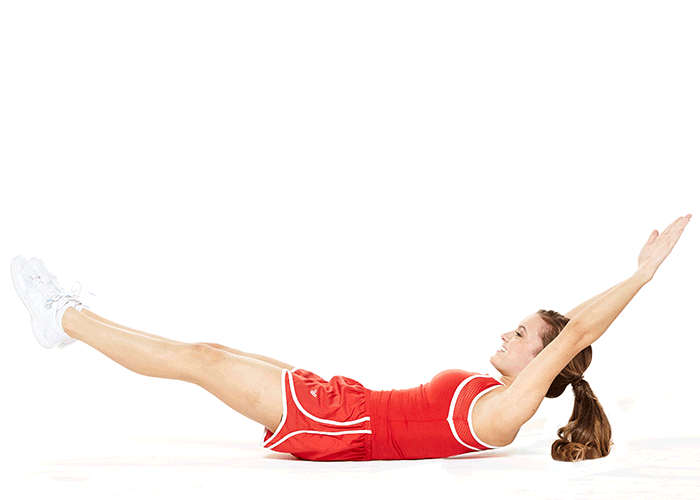

Lie face-up on the floor with your arms and legs extended straight out while lifted slightly off the floor. In one motion, lift both your torso and legs together as if you’re trying to touch your toes. Return to the first position where you first started. That is one rep.
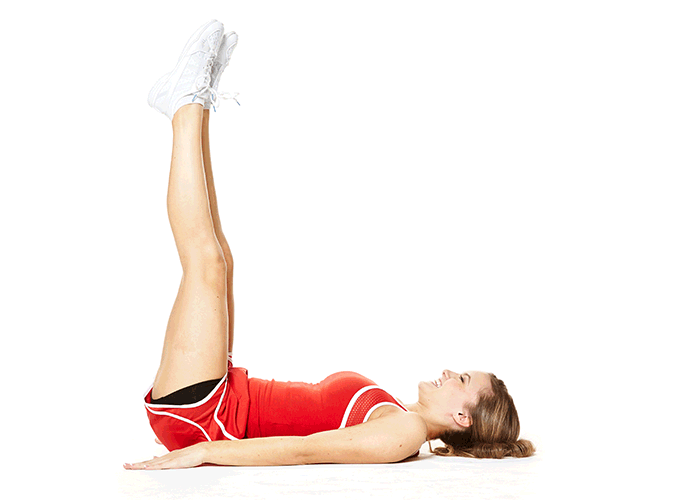

Lie on your back with your shoulders and hands on the floor. Lift your legs at a 90 degree angle. Use your abs to point through your toes and lift your legs up towards the ceiling.
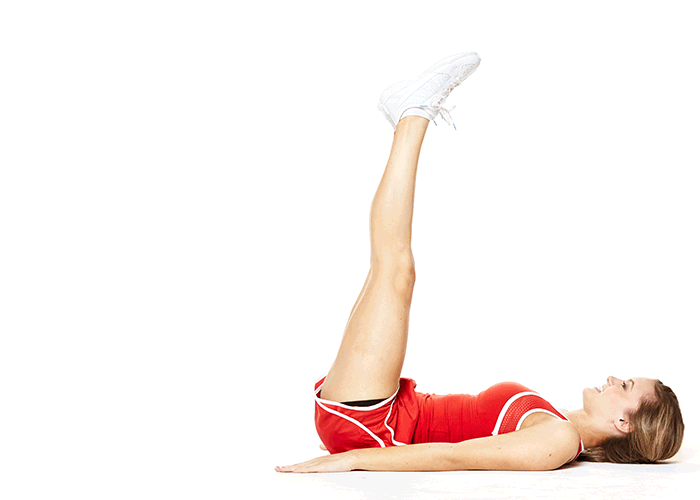

Lie face-up on the floor with one of your legs extended straight out while the other is flex to the ceiling. Contract your stomach and take a deep breath in slowly lower one leg to hover over the ground as you exhale. Continue to switch each leg from the starting position.
Jump conditioning is the second important exercise area for a cheerleader. You’re jumping, kicking, and tumbling, by having jump drills in your regiment will help build strength, stamina, and muscle memory. Repetition of good technique and form will help make it easier for you to go higher and land those tumbling skills. Check out Darin using the Home Air Floor on the cheer basics!
Fast Kicks or high kicks are the most basic yet vital cheerleading exercises you can do at home. Point your kicking foot from the floor to the ceiling until it returns to the ground. Your arms will be at a 45-degree angle at all times while kicking. Maintain good posture and keep your legs straight.
You can perform a left or right side hurdler. Throw your arms up at 45 degrees or a “V” position above your head with tight fists. Swing your arms toward each other, crossing your waist before swinging again. You’re jumping off the ground into the air with either your left or right leg straight out. The opposite leg at the knee is bent, with the inner thigh pointing at the floor.
In this jump, the legs are straddled and straight, parallel to the ground, toes pointed, knees backward are pointing up, and your hands are in fists and arms in a “T” motion.
Floor Jumps
On the floor, start in a straddle position, where your legs are at 90 degrees spread apart. Your hands will be placed; on the floor in between your knees. Lift one leg two inches off from the floor, for a count of two, and then set it back down.
Double T Jumps
Doing a double toe lift or double toe touch is the same thing but done twice. In this jump, the legs are straddled and straight, parallel to the ground, toes pointed, knees backward are pointing up, and your hands are in fists and arms in a “T” motion. Do this again to perform the Double T Jump.
● Standing quadriceps stretch
This stretch’s that front thigh muscle and can assist in avoiding injury’s before doing your sport.
1. From a standing position, bend your right knee to bring your heel toward your buttock.
2. Hold your ankle with one or both hands.
3. Keep your knees in alignment next to each other, and don’t pull your knee out to the side.
4. Hold this position for 30 seconds.
5. Repeat on the opposite side.
6. Do each side 2 to 3 times.
● Downward-Facing Dog
Downward-facing dog is a great stretch for not only your hamstrings, but great for opening your chest and stretching your shoulders.
1. From tabletop or plank position, move your hips up and back, keeping your spine straight.
2. Spread your fingers and press your weight evenly between your hands.
3. Pedal out your legs by pressing one heel into the floor at a time.
4. Hold this position for 1 minute.
● Head-to-Knee Forward Bend
This stretch’s your hamstrings which is important to avoid injury and creating long lean muscles.
1. While seated, extend your right leg and press your left foot into your right thigh.
2. Align your breastbone with the inside of your right leg as you raise your arms overhead.
3. Hinge at your hips to fold forward, placing your hands on your body or the floor.
4. Hold this position for up to 1 minute.
5. Repeat on the opposite side.
The art of freerunning is expressing oneself in the environment. Hence a freerunner. Parkour is a training discipline that uses movements developed from one obstacle to the next. It usually happens where there are large structures or buildings in the city.


The Biggest Difference between parkour and free running:


Parkour:
Freerunning:


Since the creation of Parkour in the late 1980s, Parkour has been gaining recognition worldwide. The new sport is a natural fit within several nation Gymnastics federations to offer Parkour programs and classes. In 2018, launched the first World Cup series within the World Actions Sports Festival as the biggest Parkour competition.
The Parkour adventure began in France in the 1990s, in Lisses and Evry, in the outskirts of Paris. David Bell and his friends from the Yamakasi group practiced jumping and climbing over normal everyday objects like stairs, barriers, walls, and other structures in the city. For them as teenagers, this type of training method helped them to overcome all forms of obstacles in the urban jungle as well as in natural environments like the forests. He was greatly inspired by his father Raymond Belle who was a Parisian firefighter. His father was one of the most capable recruits by smashing virtually every record they had for the obstacle course and then doubling down by winning several fire-fighting competitions, particularly being adept at rope climbing.
Raymond would test himself by devising his own obstacle course using natural objects to be the quickest as possible. He would train countless hours on practicing speed, in silence, and daring heights without injury. Raymond also learned from Georges Hébert, a famed physical education expert who also happened to be the original inventor of the military obstacle courses Raymond had used to hone his body and skills in his youth. Hébert’s training method consisted of a series of 10 basic exercises that were essentially good for overall physical fitness. Over the years the fitness regime Herbert developed, known as “The Natural Method”, grew to ten fundamental groups to include walking, running, jumping quadrupedal movement, climbing, balancing, throwing, lifting, self-defense, and swimming. It also included training in courage and morality.
Parkour Now
To watch parkour, many see an influence of martial arts and think of Bruce Lee and Jackie Chan. David Belle did spend 3 months studying in India kung fu. The philosophy of parkour is similar to martial arts but parkour is non-combative. The physical movement may be important and impressive to see but according to David Belle’s 2009 book “Parkour”, a traceur’s understanding of its principles, values, and the mental view is the most important aspect. Belle also describes parkour “as an art that requires huge amounts of repetition and practice to master.” It is a discipline.
The movements of parkour are probably as old as the human form itself. At its most basic level, parkour is simply a string of efficient and athletic movements that have been practiced, in one form or another, by athletes, warriors, monks, and entertainers stretching back millennia. Hébert, who could be called the grandfather of parkour, based his exercise philosophy on indigenous tribes he observed in Africa.
Parkour traditionalists stress the importance of physical self-reliance and freedom of movement as well as overcoming both physical and mental barriers. Personal growth is paramount. David Belle sees it as a training fit for warriors and emphasizes mastering control and focus so as to be able to perform with force and precision. Competition is frowned upon, with some adherents saying that the inclusion of any competitive elements strips the movements of the parkour label.
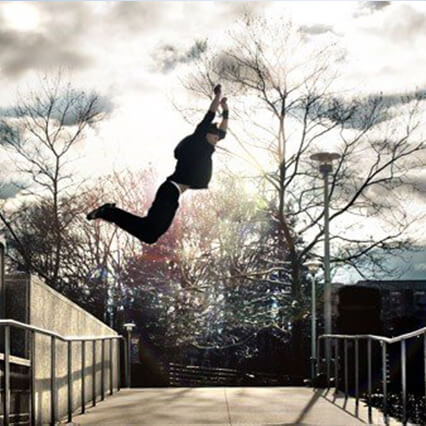

The “tic tac” is a great parkour move to start out with. This energetic move will have you up in the air in no time. Make sure your Tower Wedge is propped against a firm wall, on the tallest setting with the larger base of the wedge on the ground. This will create a roughly 45 degree angle. Start with your chest facing the wedge, about two large steps away from the base. Advance quickly to the wedge with power, leaping into the air on your second step. As you kick up towards the sky, spin towards your right or left side, using the wedge as a powerful base to pivot off of.
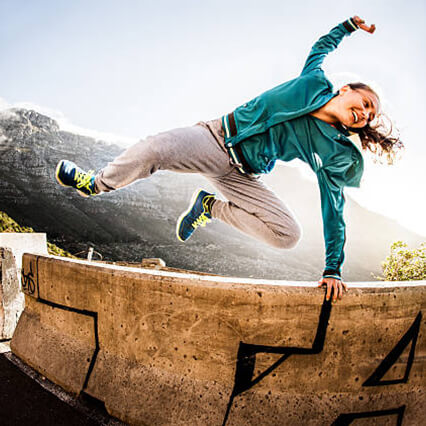

The Cat Leap is a classic parkour movement used to climb over walls. Cat Leaps can be combined with other moves to create an impressive series of steps across any urban landscape with a little height. Start by positioning the tower wedge on a vertical setting with the wider base on the floor, and the peak tilting away from you. Stand about 4 leaps away from the wedge, with your chest facing the wedge. Run towards the tower wedge and once you are about one step away from the base, leap into the air, extending both hands into the air. The aim is to reach for the top of the wall, but to allow the feet and legs to use the power of the wall to propel you upwards.
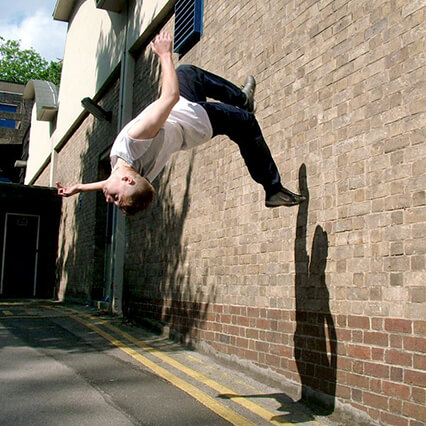

Before you try doing a wall flip, it’s important to know some basic flip moves in order to have a foundational knowledge and comfort in the movements your body needs to do to execute a wall flip. Some of these foundational prerequisite moves include a standing back tuck, a back handspring, a front flip, and even a side flip. This will be your power foot. As you spring off of the block and into your tuck, keep your back and upper body flexed- do not arch backwards.


Place your hands on the top of the wall or edge of a block about shoulder width apart. In one swift move, engage the core and bring your feet up onto the top of the wall or edge of a block in a staggered, sprinting position. This is the first part of the climb. To advance up the wall drive your lower leg upwards. Here, the power is coming from the legs and core- not just the arms and shoulders.
Our AirBox is the perfect use for these basic moves. You can punch off of it to get more air or use them for obstacles when doing moves like the cat leap or tic tacs. Our main products of our Parkour AirBlocks were made in the request for those wanting a challenge and to use something new at trampoline parks.
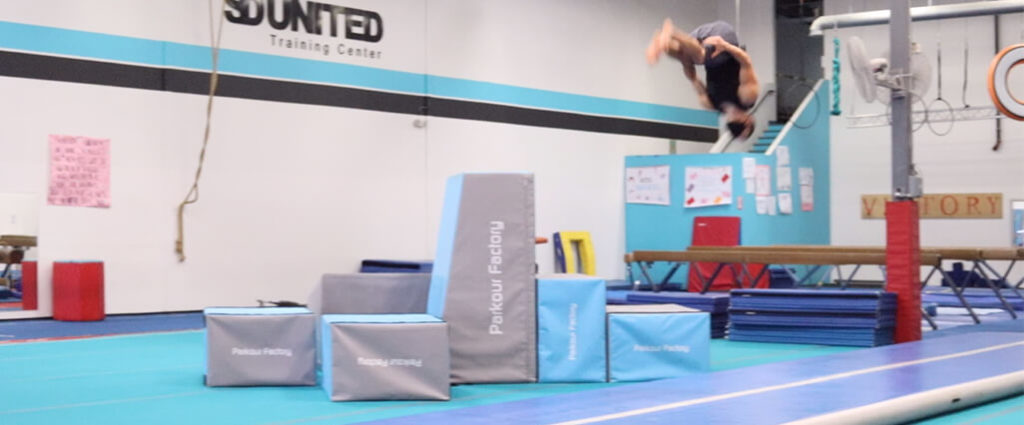

Freerunning is base is expressing oneself while running. While parkour is trying to get to point a to b. Freerunners will take their time and do it with style, they are still jumping over obstacles but not contained to the urban jungle.
Sébastien Foucan became the subject of some documentaries in the United Kingdom in the early 2000s. The word “freerunning” was coined during the filming of the documentary “Jump London”. Then in 2006, Foucan starred in the opening chase scene of the James Bond film, “Casino Royale”. This exposure brought parkour and freerunning out of its niche to the world stage.
There are differences though between parkour and freerunning. According to Foucan’s website, Foucan was dissatisfied with parkour’s limited creativity and self-expression. This led him to create freerunning. Though similar in movements, freerunning is about innovation and expression. Parkour differs in that there is more speed and efficiency in getting from point A to point B. Belle and others have been critical in Foucan and freerunning. Worldwildjam. tv says that freerunning is a mix of parkour techniques and acrobatics to serve and impress people.
David Belle attempted to trademark “Parkour” but was not successful. Therefore, many people and companies have used the name likening it to words such as “baseball”, or “soccer”. With the rise in popularity, many wanted competitions in parkour. This goes against the very philosophy of what Belle believes parkour is about. Parkour is not a sport. Competition is rivalry for supremacy whereas parkour is about teamwork, equality, and self-development. Parkour is a holistic training discipline, not just the physical aspect. Freerunning on the other hand does not have these boundaries and one can find competitions everywhere. And because it is so closely related to parkour, and without the trademark, one can find “Parkour and Freerunning Competition” together all around the world. Either way, both disciplines require constant practice and team effort to succeed.
A super-soldier like Cap would naturally be adept at parkour, and he makes great use of the discipline in almost all his action scenes, whether he is dodging in and out of view on a ship full of terrorists or chasing after the Winter Soldier through building, across rooftops, and over bridges.
A freerunning athlete is forced to compete in a parkour tournament created by a group of bloodthirsty businessmen who are looking for a new and more exciting form of gambling where actual human lives are at stake. Failure to win the race means the bomb attached to your neck detonates. The premise of the movie is rather forced, but once you get to roll with it, you can focus on what this movie truly is: a comprehensive showcase for all the ways in which parkour techniques can be used to clear obstacles, performed by some of the best athletes in the field.
Style and theatrics are an important part of freerunning. For instance, while a traucer would simply vault over a wall as fluidly and quickly as possible, a freerunner might flip off the wall. The point is not to move as quickly as possible, but to be creative, improvise and express oneself. Philosophy plays and even more important role in parkour than in freerunning. In fact, many of the most prominent athletes in parkour have clarified that parkour is not a sport, but an art, or a discipline. There is an intense focus on the self, on merging mind and body, and being able to overcome physical and mental obstacles. Belle has described parkour as a means of self refinement and improving physical and mental control. An emerging philosophy of parkour is that of human reclamation, or moving naturally through an environment in a way that has been lost in civilization. The idea is to interact with and use the physical world, rather than simply be directed by it.
Running, Jumping, and Landing
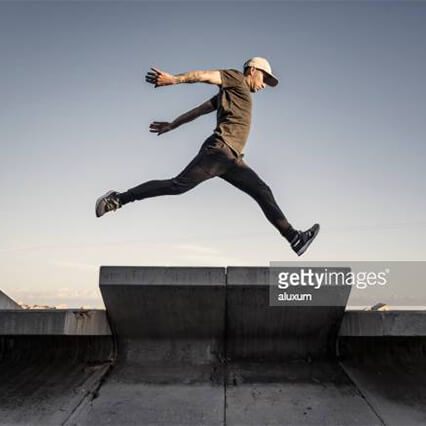

You need to develop a good basic stamina and strength. Running, jumping, and landing are the most important and basic moves you can do in starting freerunning. Practice doing drills of these three in a park or at home. When you land you’d want to do a tucking roll by tucking in your head into your body and roll on your back. You might recall this landing move as a ninja roll when you see Youtube videos when freerunnings jump and land into it.
Jumping Over


When jumping over things, there are two aspects to it – jumping vertically to clear a tall object, and jumping horizontally to clear a large or long object – and many jumps will involve some of each. Take a small run up to an object and leap completely over it without slowing down or touching it, leading with one foot and lifting both legs to clear it, and continue running after landing.
Swing Through
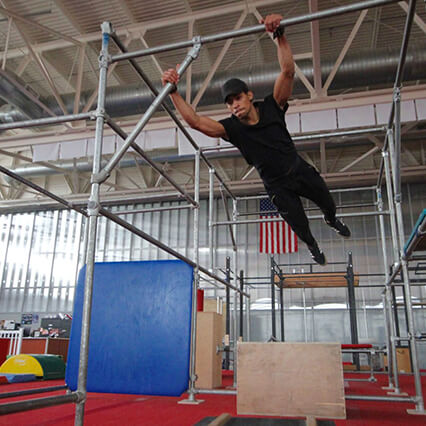

To practice and gain the strength to properly execute it, begin by running up to a bar (playgrounds are awesome for that), jump for the bar with your hands, and swing your body underneath you, letting go of your hands to land away from the bar. Once you can catch the bar and swing under it confidently, mark out an area beyond the bar to land in, as if you’re hitting a target, and as you jump, lift up your legs and curl your body, pretending that you’re going through a smaller opening.
Vaulting
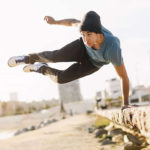

Being able to clear fences or walls or other obstacles with just a single touch of the hands is a pretty cool looking move, but it isn’t as hard as it might seem. At the basic level, a vault involves making a leap with your body up and to one side (not straight over, as in the previous example), using your hands to direct and propel your body over the object.
Our Airtrick was made for those who want to try out their skills, practice them, or hone in new ones. The AirTrick is thick and wide enough for practice your freerunning or tricking skills.
Many people come to us when summer rolls around with the simple question of; can I take my AirTrack mat into the pool? Yes, of course you can. Our mats are made with high quality materials that allow the mats to successfully float. Plus they can be inflated within 3 minutes with the manual air pump or 30 seconds with the electric air pump. They will have a long shelf life as long as you are taking care of them properly.
Doing gymnastics exercises on an airtrack in the pool adds an extra level of difficulty to each trick, because you have to readjust on an unstable mat. This is a great way to strengthen your already known tricks. All these skills should be mastered on solid ground before taking to the pool. Clear it with a professional coach, exercise caution and safety and then take that air mat and toss it in the pool to start mastering these 4 gymnastics exercises.
Here we will go over some fun gymnastics exercises to do on an inflatable tumble track.
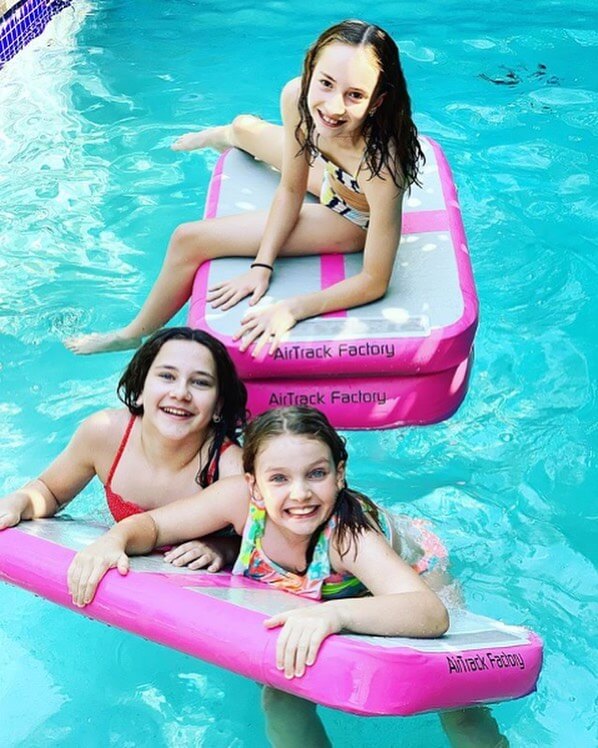

View this post on Instagram
Handstands and bridges are iconic in the gymnastics world. One of the first moves learned in the sport. This can easily be done on a water gymnastic mat such as an AirTrack. Here you can get more strength to perfect these moves on solid ground. It is a fun addition to any pool day.
View this post on Instagram
Back handsprings are a cool trick to learn, let alone on a floating tumbling mat. Although, it is dangerous if you don’t have the skill mastered on solid ground. So, make sure you consult a professional before doing so and get ready to relearn this trick you thought you had in the bag!
One back handspring should fit on our Home AirFloor while two back handsprings can fit on the Home AirFloor XL!
View this post on Instagram
If you thought a game of back tuck “Stick-It” was tough on the spring floor, just wait until you try to take it to the pool. In a normal setting using an inflatable air track for gymnastics offers bounce, explosion, and height – turning our air mats into a water gymnastics mat means all that energy is absorbed straight into the pool.
Practically, it means you better jump high and prepare to get wet. Give yourself plenty of room, because no one is coming out dry on this one.
View this post on Instagram
So here’s a trick to know, the bigger the air track the more stable your training will be. For skills like the Arabian, consider an AirTrack P2, AirTrack P3, or Spark tumbling mat for the pool. Those larger mats will provide more space and more stability to master any higher level water gymnastics skill you can imagine.
Another trick to know, our mats are durable but not indestructible. Taking air mats out of their intended environment of the gym always carries risk of damage. Luckily, all our AirTrack mats come with repair kits, a simple and easy fix for any leaks/holes that may happen.
View this post on Instagram
The best part about using the AirTrack as a floating gymnastics mat, is the fact that it is extremely versatile and compact. You can easily pack it up and bring it to a friend’s house, or for the truly visionary users of AirTrack, perhaps ocean or lake gymnastics are next. What are your favorite pool gymnastics moves?


Reference the map and shipping deadlines below to ensure you allow time for your shipment to arrive in time for the holidays. Please keep in mind that all the dates provided below are best estimates and holiday and shipping delays may affect them.


_____
| Product | In Stock | Dispatch from Warehouse | |
| Home AirTrack | In Stock | 1-3 business days, will arrive after Christmas | Product Page |
| Home AirTrack Pro | In Stock | 1-3 business days, will arrive after Christmas | Product Page |
| Training Set | Backordered | ~4 weeks, will arrive after Christmas | Product Page |
| Training Set Plus | Backordered | ~4 weeks, will arrive after Christmas | Product Page |
| AirBeam 10 & 16 | Out of Stock | 8-12 weeks, will arrive after Christmas | Product Page |
| AirRoll, both sizes | In Stock | 1-3 business days, will arrive after Christmas | Product Page |
| AirBoard | In Stock | 1-3 business days, will arrive after Christmas | Product Page |
| AirTrack 3 | In Stock | 1-3 business days, will arrive after Christmas | Product Page |
| AirSpot | In Stock | 1-3 business days, will arrive after Christmas | Product Page |
| AirFloor | Made to Order | ~8-12 weeks, will arrive after Christmas | Product Page |
| AirTrack™ P2 | Made to Order | ~8-12 weeks, will arrive after Christmas | Product Page |
| AirTrack™ P3 | Made to Order | ~8-12 weeks, will arrive after Christmas | Product Page |
| AirTrick | Made to Order | ~8-12 weeks, will arrive after Christmas | Product Page |
* Please remember these are estimates. Delivery timelines are subject to change dynamically.
AirTrack™ orders of in-stock products will be fulfilled in the order they were received. Please allow 1-3 business days after ordering for your order to ship. All orders are shipped via UPS Ground. Once your order is on its way, you will receive a shipping notification email with your tracking information enclosed. Make sure to check spam folders as sometimes shipping emails can be flagged as such by email providers.
All in-stock products ship via UPS Ground. For an accurate estimate of your transit time, please consult the map above. Please note that our boxes are branded and some shipments may require a signature to ensure a safe delivery. Smaller items such as Repair Kits and Foot Pumps may ship via USPS instead.
Items must be returned within 15 days of delivery in order to be eligible for a refund or exchange. To be eligible for a full financial refund on your return, your item must be unused and in the same condition that you received it. It must also be in the original packaging.
To initiate a return inquiry, reach out to us directly at customerservice@airtrackus.com.
For more information on our complete refund policy, please see our return policy page for details.
Yes! Please reach out to us directly at customerservice@airtrackus.com and we will try our best to accommodate your request.
_____
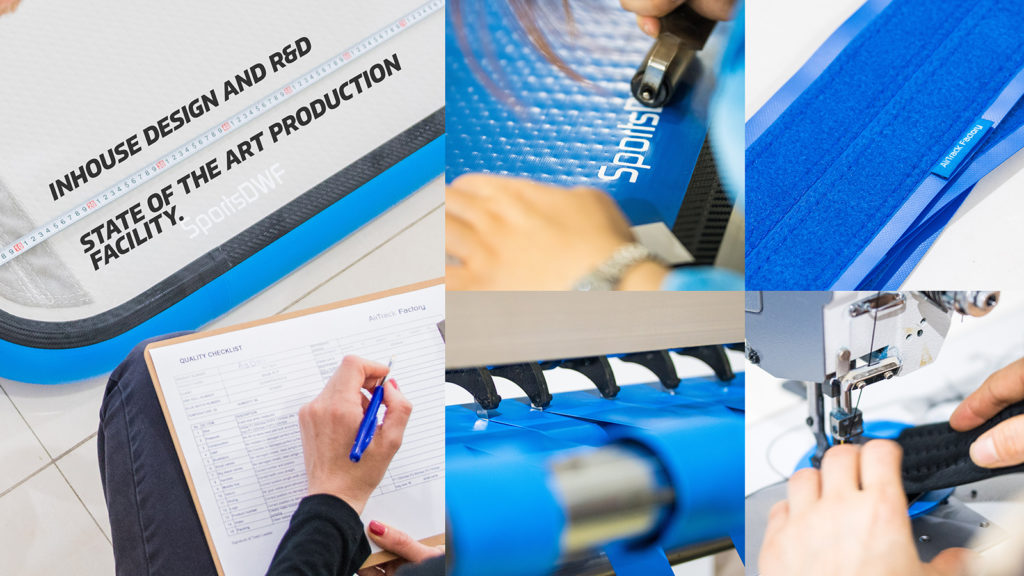

Floating exercise mats have come a long way since being just foam. Nowadays, there are various foam and inflatable floating exercise mats that are available. Here, we’ll show you the difference between the floating exercise mats and our inflatable AirTracks. Our inflatable AirTracks are heavy-duty, with a high-grade double wall fabric that is water-resistant.

| Data Info | Home AirAiTrack | HomeAirTrack Pro | AirTrack P2 | AirTrack P3 |
| Length/Width | 3’x10’, 3×16′, 3’x20′ | 3’ x 16’, 3’x20′ | 6.5’ x 20’ / 50’ | 6.5’ / 9’ x 20’/ 50’ |
| Thickness | 4” inches | 8” inches | 8” inches | 12’ inches |
| Color Options | Y | Y | N | N |
| Price Range | $249.00-$399.00 | $649.00-$849.00 | $2,085 – $4,765 | $2,235 – $6,885 |
| Stored Size | 50 x 35 x 32 cm / 100 x 50 x 35 cm | 80 x 50 x 25 cm / 110 x 70 x 38 cm |
Our Home Airtrack line offers a great deal on the mats while providing a wide collection of colors including; blue, mint, teal, pink, purple, and red. Our heavy-duty and water-resistant double wall fabric is perfect for the grass or in the pool.
You can step up your at-home gym training by combining different Air Products like AirRoll or AirBlock. With the Training Set it combines our best home Air Products giving you the ultimate tool you can use for your home gym! Our versatile air mat is perfect for at home, on vacation, or at a park; you can still train like you’re in a gym!
Our AirTrack P2 is the perfect and most popular tumbling mat. With 8-inches of thickness, it is the middle ground thickness for tumblers, cheerleaders, and other gymnasts alike. You can see here @britthertz on the inflatable AirTrack gives you enough surface area to tumble in the pool or into it. It is big enough to tumble on still, be portable for travel.
At 12-inches thick, the AirTrack P3 is our thickest and signature product. The perfect tumble trampoline replacement for power tumbling and skill development is needed to compete at the most elite levels. With our AirTrack P3 air mat, from high leveled skill or tumbling pass can be performed on it. See here Dude Perfect using it perfectly for a slip and slide too!


Beyond practicing your gymnastics, cheer or parkour moves, our AirTracks provide the stability you need to workout in the pool, as well as on land. Unlike other floating fitness mats, they are not intended for a single use and can be used for yoga, Pilates, balance and core strength training, mediation and even recovery training.
Yoga in the pool is a low impact exercise that makes it ideal for people with joint pain or injuries to improve their strength, flexibility and range of motion.
Yoga moves like the plank, downward dog, chaturanga, and cobra are all perfect on the mat. By using it in the water, it adds a little twist to your regular yoga practice.
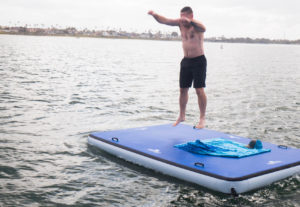

There are many different categories and types of fitness, for example, Pilates, kinetic fitness training, yoga, and many other types of exercises. These types of exercise mainly use the body-weight to working out. Protecting your body from injury or even giving you a different playing field that could change up your routine. These basic four moves on our air mat and will support you all the way through.
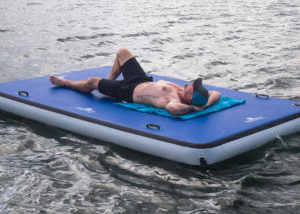

Similar to yoga, meditation is a great way to destress and relax your mind and body. Meditation helps control your breathing and able to have clear thoughts. While performing yoga on our air mats in the pool will give a different sense of calm. When you’re rocking on your air mat on a calm pool during the morning can be very relaxing.
Also, you’ll find the benefits of meditation also include:
Meditation can also help with the following physical symptoms:
To meditate on a floating mat, you can either sit on the mat while in the pool or lay out on your back. Concentrate on your breathing, breath in for 5 hold for 5, breath out for 5 and hold for 5. Continue to focus on your breath and try to relax for anywhere between 5-30 minutes or as long as you feel the need.
Learning how to have stability of the mat and can help rebuild proprioception and kinesthetic awareness loss resulting from an injury. Having the mat on the pool makes it a bit easier on the joints because you’re not fighting gravity too much, just the motion of the water. Hydro exercises naturally make it easier during rehabilitation, the water helps reduce the weight on the injury. Building core strength, stability and stretching to bring back range of motion is a great way to come back from an injury.
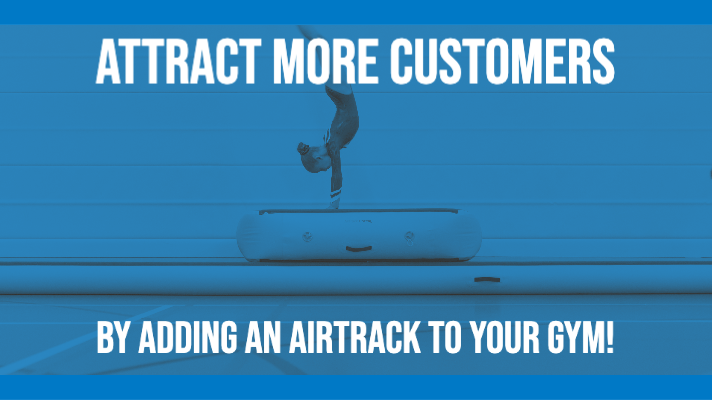

Are you looking to attract new customers, differentiate your facility, but not break the bank? Investing in an AirTrack offers your gym extreme adaptability and flexibility for your customer, facility, and service offerings. An AirTrack opens the door to new tricks, activities, and programs. At AirTrack Factory US, we can offer you the BEST AirTrack for your gym. The only limitation is your imagination!
AirTracks are a cross-sport piece of equipment!
AirTracks have moved beyond traditional gymnastics and are now used in every sporting market: Dance, Parkour, Martial Arts, Cheer, and Cirque. By purchasing an AirTrack you open the doors to new program opportunities. Maybe you’re a gym wanting to ramp up your parkour classes or you’re a dance studio looking to expand your Acro program? The programmatic possibilities are endless with a guaranteed return on investment! An AirTrack will diversify your service offerings and fill your new classes with new students.
Add an AirTrack to your next birthday party!
Most gymnastics and cheerleading facilities host birthday parties as an additional program offering. A fun activity for all ages, but desperately needing new inspiration. What if we told you, we could shake up your party offerings with an AirTrack?! This is the perfect opportunity to test an AirTrack and reinvigorate your party planning. Our AirTrack Factory Gym-Take-Over program offers an opportunity for gyms to experience what AirTracks can do for their facilities and their customers.
Use AirTracks for Mobile Marketing!
Finding new and exciting ways to attract students and increase enrollment can be challenging. Investing in an AirTrack gives you the opportunity to safely bring your gym to the community. Head to your local community festival or give your audience a performance on the beach! Show your community firsthand the value and excitement of gymnastics, cheerleading, martial arts, tricking, etc. AirTracks are the perfect partner for mobile programs and Set-Up/Tear Down Gyms. Explore new setups and imagine new possibilities while keeping your students safe while they train. All products are airtight, light-weight and of the highest quality!
With 35 years of experience producing inflatable mats, AirTrack Factory US is the leading manufacturer of AirProducts. We’re more than an equipment supplier, we’re on the forefront of inflatable innovation designing equipment that progresses your athletes, inspires your coaches, and supports your business. We can offer you the BEST AirTrack for your gym!
Let us help you bring versatility to your business and growth to your customer base. Purchase your AirTrack today!
Guest blogger Dan Palacios
Original Posting
It isn’t often that great ideas are so easily implemented, coming together with the kind of synergy only seen in matters of fate. That’s exactly what happened when I stumbled upon the AirTrack Factory AirSpots.
Mulling and musing over the ideas of gym layouts I always thought to include gymnastic spring floor. A spring floor in a traditional style gym? Kinetic Training hardly does anything the traditional way. You’re right though… spring floors are incredibly costly, financially and spatially. Not to mention their foamy surface could pose a problem with ankle injuries. Certainly there were pros and cons to this idea.
Watch The Kinetic Training AirSpot Demo Here!
Then I saw it. The AirTrack Tumbling track. Their Instagram @AirTrackFactory is rife with expert gymnasts flying around with impressive and apparent ease completing tricks that would make an pro gymnast blush. I knew I had to have them. Upon further inspection of their website www.airtrackus.com I quickly came to realize that these guys were real trailblazers in the industry. They not only offered the AirTrack Tumble tracks but a wide variety of designs, everything a gym owner could need for a full size gymnastics facility. Still, I needed a low profile piece that could easily fit in my truck for on-site training sessions or sessions in the gym. The AirSpots solved all of my problems
These nifty circular, portable spring floors are easily collapsible. They come in small, medium, and large sizes, only take about 3 minutes to pump up and can take just as much of a beating as their bigger, older brothers. The medium and large sizes also offer plenty of room to do various types of traditional, sport specific, corrective, and rehabilitative exercises. These AirSpots quickly became a fan favorite for me personally and my clients. The adjustable inflation means, that extra stability, or instability can be added to quickly progress exercises through a range of exercises to correct ankle and hip stability issues. The added cushion is a fantastic way to increase the power, speed, and explosiveness output while reducing the impact on the joints. The AirTrack Sport surface provides all of the added spring of a trampoline or spring floor without the increased risk of ankle or knee injuries. This thing is really a win, win overall!
Visit: us.airtrack.com to check out the wide variety of AirTracks available for gym or home use! Use the DISCOUNT CODE: Kinetic10!
About Dan Palacios
AirTrack mats have their history in traditional gymnastics and tumbling gyms. The fact that they were filled with air brought benefits to reducing training injuries, flexibility in setups, placement around the gym, and faster transitions to the spring floor due to the similarities in technique and timing compared to the slower elongated techniques that tumbling trampolines required.
With the rise of trampoline and freestyle parks we’ve seen a tremendous increase in adoption of these traditional air training devices into new environments accompanied with new and innovative setups. I don’t think intuitively this surprises anyone with any experience in gymnastics or tumbling. However, it’s still worth asking the question, why? What is the benefit that athletes intuitively feel and owners have picked up on?
The three most powerful driving forces as we’ve experienced are: Attracting a new type of customer, Pressure to differentiate facility, services, and activities, and low cost compared to similarly sized attractions.
Traditional trampoline parks have their limitations – mainly – the trampoline. Keep in mind that the trampoline has 2 things working against it. The vast number of tramp tricks are out of physical and talent reach of most trampoline park attendees compounded by the black bed of trampolines being designed to reduce top height reached. Bed area was shrunk with a nod to attendee safety, the trampolines themselves add an additional level of limitation to tricks and activities.
What you’re left with is a narrow space of activity that resonates with a specific segment of younger kids with average to below average physical abilities – to be fair, a massive market still.
Installing an AirTrack mat creates a space that opens the door to new tricks and activities which in turn attracts a new demographic – the practicing athlete. More specifically, we’re talking about cheerleaders, gymnasts, martial art trickers, dance acrobatics, and circus artists.
These new customers are able to bring their skills and tricks – which don’t normally translate well to the trampoline – now to the park. I’m referring to skills like: extended tumbling, handstands, simple cartwheels, traditional forward rolls, back walk overs, off-angle flipping, and twisting with reduced fear of careening out of control.
Perfect examples from Flip N Fly and KTR
These practicing athletes now have a “reason” to go to the park. Whether it’s to get additional training in or show off for friends or family they can do what they couldn’t do before given the limitations of the trampoline.
Attendance fatigue is a very real challenge parks run into. That fatigues puts pressure on owners and GMs to mix things up, keep things fresh. This is where the AirTrack excels.
Lets illustrate the simple point with a thought game imagining how the AirTrack is used by minute, by day.
At any point in time on the AirTrack a cheerleader does a tumbling pass, quickly followed by a martial arts trick doing a swing through. The court monitor might then organize a relay race for a group of 5 year old’s followed by a game of dodge ball with 15 year old’s. Afterward foam blocks are pulled on top of the AirTrack mat and a complete parkour course is created in the span of a few minutes.
Zooming out, the GM moves the AirTrack from one side of the park to the other giving the facility a fresh look from a Thursday to a Friday. And finally, the Owner deflates the AirTrack and brings it to the town Art & Wine festival for a marketing and outreach opportunity that Saturday.
The AirTrack’s main attribute is it’s flexibility. Flexibility of activities that can be done on the mat. Flexibility in the customer base that interacts with the attraction. Flexibility of it’s physical placement in or around your facility. That flexibility gives your facility, your staff, and your services the opportunity to adapt in ways that steel structures are unable.
New attractions are expensive. Attractions that take up a substantial footprint are doubly so. Value and “bang for your buck” are extremely important. Through put rates and usage percentage all have to be considered.
Groups are finding that an AirTrack mat can compliment or even rival the main tramp court as a standard baseline attraction that appeals to a wide base of customers while also accommodating higher usage and faster through put. By any metric, zip-lines, ninja warrior courses, warped walls, and parkour courses can’t match an AirTrack attraction.
This is only strengthened when you’re considering a renovation or replacement. Budgets become tighter and decisions all the more important.
Baseline costs for an AirTrack may start you around $2900 with larger mats running ~$8000. Which ever direction you go, the AirTrack matches up well against other trending attractions.
The list of high profile parks that are installing AirTracks is undeniably growing. These recreational facilities are seeing the benefits that traditional training facilities have enjoyed for decades. As attraction movements go, it is worth your consideration – www.airtrackus.com
You can find a growing gallery of projects here.
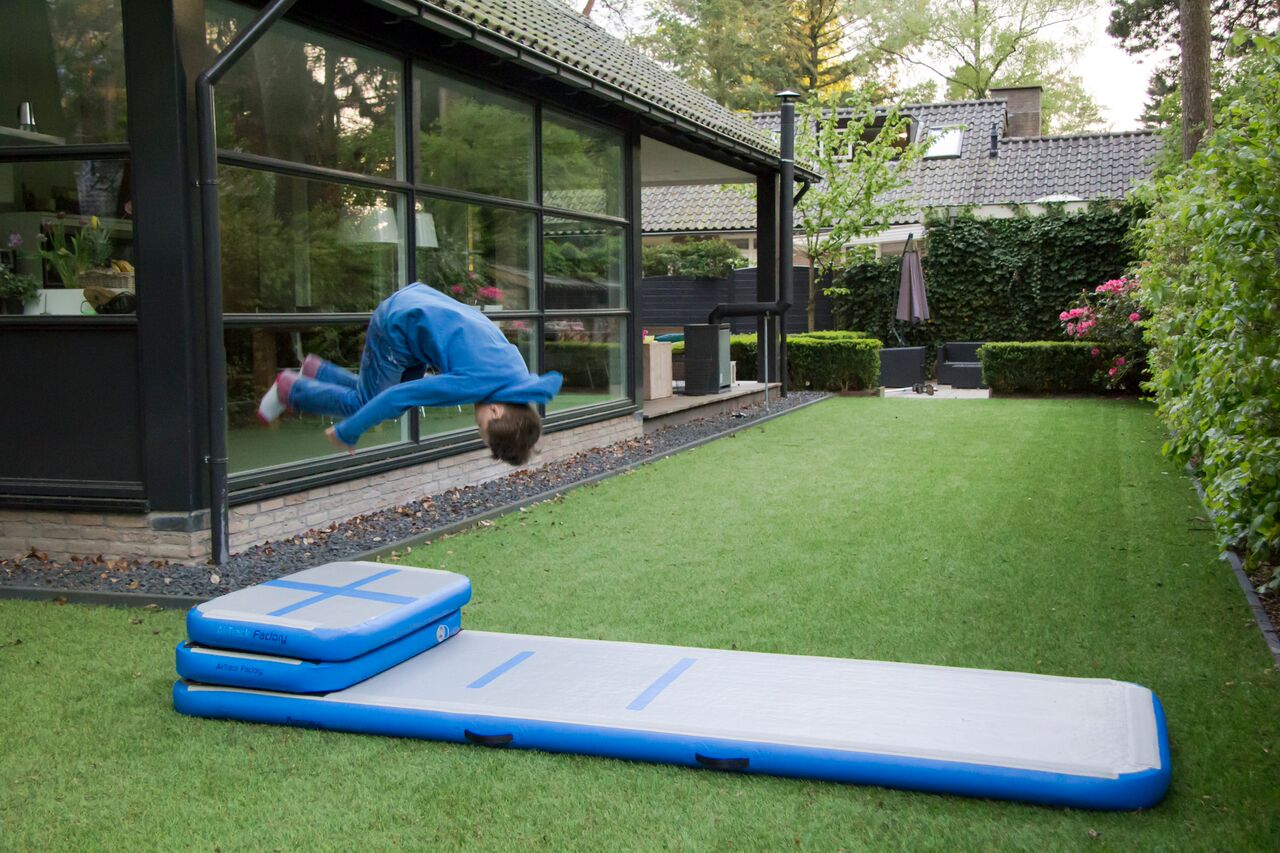

Many parents question if it’s safe for their kids to practice gymnastics at home. The truth being that it can be, safe, if practiced with the correct equipment like gymnastic mats for home, supervision, and attention to technique. Some key foundational pieces of equipment that are worth investing in are good quality gymnastic tumbling mats for the home.
Inflatable mats are smaller, more affordable, and portable than their full-sized counterparts. They also offer the level of quality found in professional gymnastics, parkour, and martial arts studios. In particular, the mats offered by AirtrackUS are ideal for practicing gymnastic moves. For example; kick walks, forward rolls, bridges, and split leaps. Using a top-of-the-line mat at home to perform these exercises can help reduce the chance of injury and minimize repetitive strain. The key is to do your homework and find the best airmat for your needs.
The best gymnastics mats for home are inflatable, rather than made of foam. Inflatable mats provide an advantage for several reasons. They are softer on the body than foam, providing a more supportive landing surface. This helps minimize impacts on the wrists, ankle, and knee joints, which is crucial to gymnasts of all ages, considering some of the most common gymnastic injuries are sprains in these delicate areas. Another advantage of choosing an inflatable floor mat is the ability to easily store and transport the mat. When deflated, a well-designed airmat is small enough to fit in your car! These airmats inflate within minutes using an affordable and readily available electric pump. Consequently, they are easily brought along on road trips, stored during the off-season, or easily transported indoors or outdoors depending upon the weather. Since they are sealed, they do not require constant air to be blown in, making them silent and non-disruptive to the rest of your home. Finally, because airmats are inflated, they can be customized to the firmness required by your athlete. If you need further convincing, see how some of the best gymnastic, parkour, and martial arts athletes are using products like this. Take advantage of the fact these reliable and high-end products are now available at home.
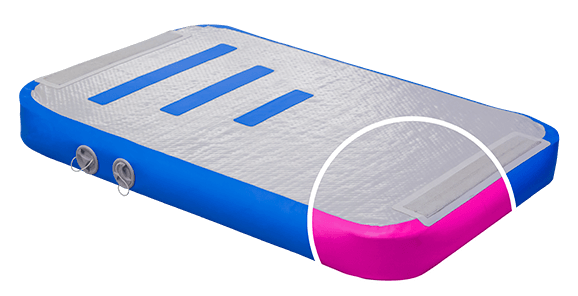

Any parent will agree that the costs of gymnastics classes, memberships, and sportswear add up fast. However, when it comes to equipment, it’s wise to avoid the lower-end choices. Only the best gymnastics mats should be chosen. Especially regarding tumbling mats for the home. To ensure the life of your airmat, select a brand that uses durable, washable, material with reinforced stitching. This will help you avoid spending twice to replace ripped, dirty, or worn-out equipment. AirtrackUS utilizes extremely high, self-imposed quality standards, to ensure the virtue of their products. They put each mat through a 16-hour pressure test, and mark each unit with a code to track it’s manufacturing history and test results. Airtrack US, also offers a 2-year guarantee, and have over 30 years of experience in the industry. There aren’t many other companies around that can offer the same level of quality.
Your gymnast’s equipment needs depend on their current skill level, the specific types of moves they are working on, and what they want to hone in on during home sessions. Of course, the space you have available in your home is also a factor determining what’s possible. Luckily, AirtrackUS offers a range of products including airbeams, airmats, and training sets that can be set up in a variety of different spaces, both indoors and out. Make sure to pay attention to other factors like your ceiling height, walls, unlevel flooring, and anything else that could be a safety hazard. It’s a good idea to whip out your measuring tape and call the customer service team to help figure out the ideal product for your needs.
Great customer service can go a long way when it comes to making recommendations on different product options, offering payment plans, and answering commonly-asked questions that come up when purshings at home airmats for the first time. When investing in gymnastics tumbling mats for your home, it’s wise to speak to a friendly team that’s knowledgeable about their products. They will ask you the right questions to ensure you are buying what you actually need.
The increase in popularity of gymnastics, parkour, and martial arts in the United States is causing an increase in the demand for high quality airmats that can be used at home, or in a communal space. If you’re interested in investing, check out what other teams are doing with the latest generation of airmats. Buy from a company that’s been around long enough to truly understand the needs of both beginner and professional gymnasts.
While structured classes in a gym environment are essential to developing the skills and strengths gymnasts need, an at-home practice is also key for developing the confidence and strength. Invest in a high quality inflatable airmat to give your family a safe place to practice year round. Keep in mind that these mats can also be taken on the road for practice during vacations and tournaments. And, have fun outside! Gymnastics tumbling mats for home help you make the most of the great indoors. Don’t skimp on quality, and make sure to find a company that offers great customer service to help you find the best equipment for your space.


Cheerleading has become one of the most competitive sports in the country, and it’s no surprise. Contemporary cheerleading features exciting stunts and tricks that captivate audiences across the nation, and has even sparked a trend for cheerleading movies, camps, and blogs. Cheer teams are setting increasingly high standards for the sport, incorporating new and difficult gymnastic stunts that require training, practice, and appropriate cheerleading equipment. In fact, the National Athletic Trainers’ Association has just created a series of guidelines aimed at protecting cheer athletes across the country. In response, cheerleading equipment manufacturers are offering a range of products suited towards setting up safer gyms, and coaches are using a variety of new techniques and safeguards to keep athletes healthy. Cheerleading is now regulated at the middle school, high school, and college levels. The American Association of Cheerleading Coaches and Administrators’ now offers guides and education to help keep the community safe. Cheerleading teams in the NCAA now require coaches to get a safety certification. Consequently, injury rates, including concussions and sprains, have significantly decreased since 2006. This article explores how new equipment can help promote safe practices for your cheer squad.
Good cheerleading equipment starts from the ground up. The National Cheer Safety Foundation reports that roughly 93 percent of cheerleading injuries occur on hard gym flooring, concrete, or on surfaces that are not adequately covered by supportive mats or crash pads. Many of these injuries happen while a squad is performing or practicing stunts, like pyramids, shoulder sits, basket tosses, or other stunts involving a flyer, without proper cheerleading equipment. Since stunting is becoming more popular, it’s crucial that teams use appropriate AirTrack or mats during training in order to prevent injury. How to decide what type of flooring equipment is needed? Start by considering the difficulty of the stunt, and then consider the height at which the stunt is performed. Stunts performed at a higher range equal a greater risk, thus a greater need for protective mats and floors.
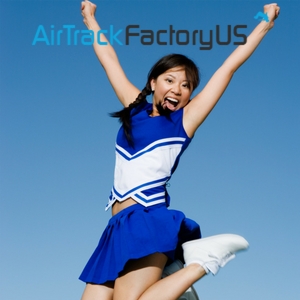

During cheerleading training, safety mats are often used to support flyers that are dismounting from a stunt or landing a tumbling trick. These mats are anywhere from eight to thirteen inches thick, and are made of a high-density foam that helps support an athletes as they land, or provides cushion in the case that they accidently fall. Cheerleading coaches often combine mats with an air track in order to provide an extra layer of support during cheerleading tumbling or stunting training. Safety mats are not typically lightweight, but their smaller dimensions make it easy to store and transport them. They are covered in an easily washable and repairable material that is designed to withstand repeated blows. Every cheerleading team should practice with adequate mats, and with such a great range on the market, there’s no excuse to go without.
Manufacturers are now addressing the market for home and outdoor cheerleading equipment by offering smaller-sized air track and folding mats. A good home air track has all the benefits of a regular-sized air track, except it is smaller, lighter, and more affordable. A folding floor mat is also a great option and can often be customized to your cheer team’s colors. Opt for an option that is made with good quality foam and durable vinyl; it may require a greater investment upfront, but will last for several seasons. Cheerleaders can use this equipment to more safely practice tumbling while on the road, or in an outdoor setting. While it’s not advised to attempt stunting or tumbling outside of a supervised setting, enthusiasts can practice the basics at home knowing that they have a greater level of protection and joint support on the mat.
Flyers need to have excellent balance to keep themselves and their team members safe. Have your team take turns standing on the airroll– they’ll have to keep their core engaged in order to keep stable. Airrolls are a great tool for cheerleaders to develop core strength while practicing balance, and supporting the strengthening of the muscles surrounding the ankle. Though simple, this piece of cheerleading equipment is great for athletes to use in between routines, during warm ups, or during down time.
Today’s manufacturers are offering an upgrade on the wooden or metal cheer stands of the past. Contemporary models are made with durable, lightweight materials and offer a more stable base. These can be used to practice balance, and to support ankle strength during training.
Use wedges and airramps in your floor set up to provide a safer experience as athletes tackle complex tricks like backsprings and flips. Wedges can be set up in combination with airfloors and landing mats in order to provide support for cheer athletes that are attempting to learn specific tricks and tumbling moves.
Strong muscles and joints are the first step to preventing injury. Stamina and core strength are key to consistently practicing good form and landing stunts. As soon as an athlete gets tired, they are at greater risk for injury.
Use the correct flooring and mats recommended for the type of stunts your team is working on. Make sure they are adequately sized, properly inflated, repaired frequently, and safely stored.
There are several guidelines and training courses available to ensure that you’re following the best safety precautions. The Pop Warner Rules Book, the Youth Cheer and Dance Alliance, the NCAA, and the American Association of Cheerleading Coaches and Administrators’ all offer extensive guides and documentation.
When learning stunts, ensure you have properly trained spotter present and focused at all times. In the case that someone does fall, you’ll have a team ready to spring to action.